Leadership in HR: Styles, Culture, Diversity, and Structure
VerifiedAdded on 2022/12/14
|9
|2752
|471
Report
AI Summary
This report delves into the critical aspects of managing people within an organization, focusing on the interplay between leadership styles and organizational structure. It begins by contrasting management and leadership, emphasizing the distinct responsibilities each entails, particularly within the context of the Losch Group. The report then explores organizational culture and structure, highlighting their impact on employee performance and the overall success of the company. It examines the importance of diversity and equal opportunity, outlining legal requirements and benefits. The report concludes by stressing the significance of effective employee management, motivation, and the recruitment of talented individuals to achieve organizational goals, particularly in a car company setting. It emphasizes that leadership is more effective than management in leading employees and key organizational activities. The report also highlights the importance of maintaining diversity within the organization.
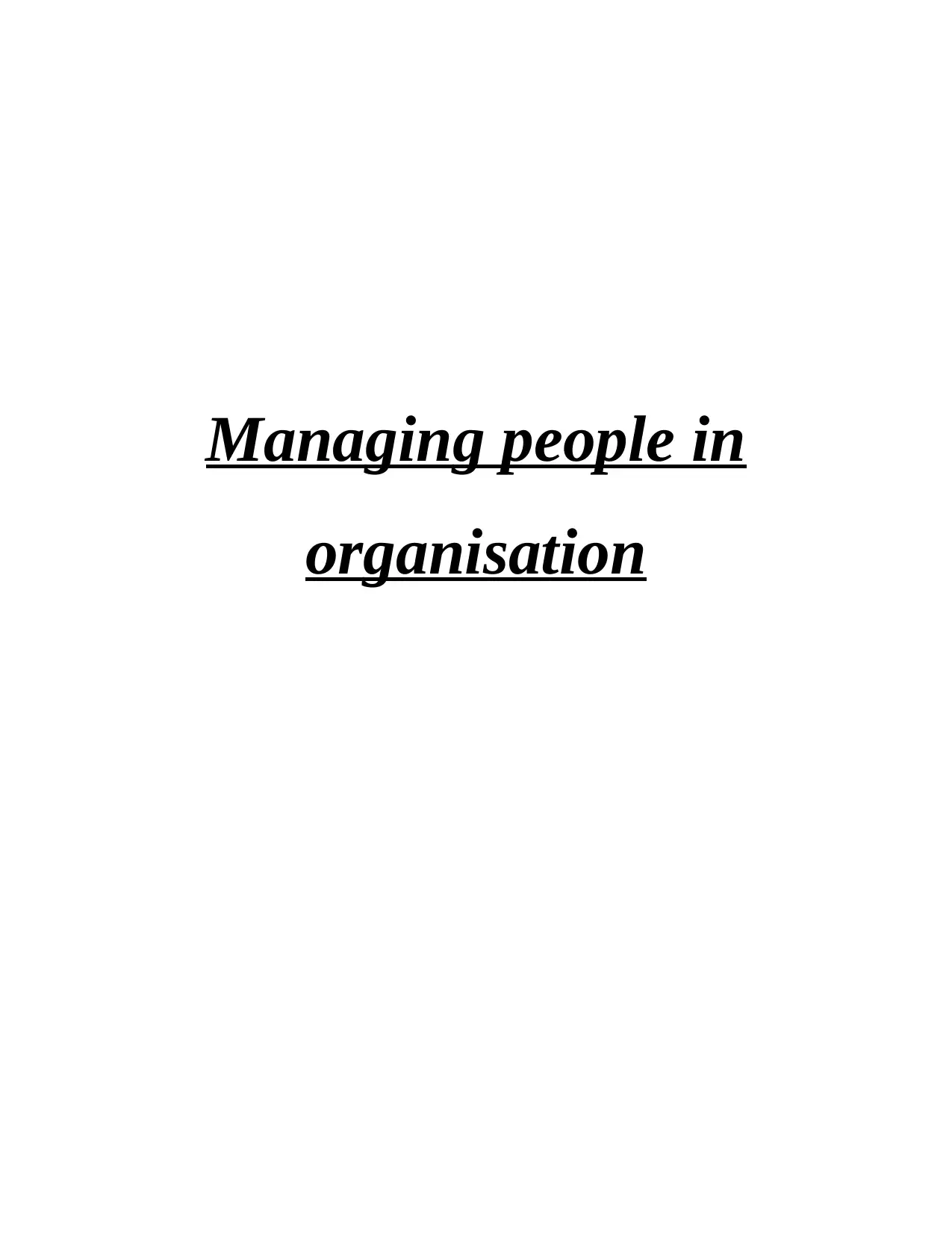
Managing people in
organisation
organisation
Paraphrase This Document
Need a fresh take? Get an instant paraphrase of this document with our AI Paraphraser
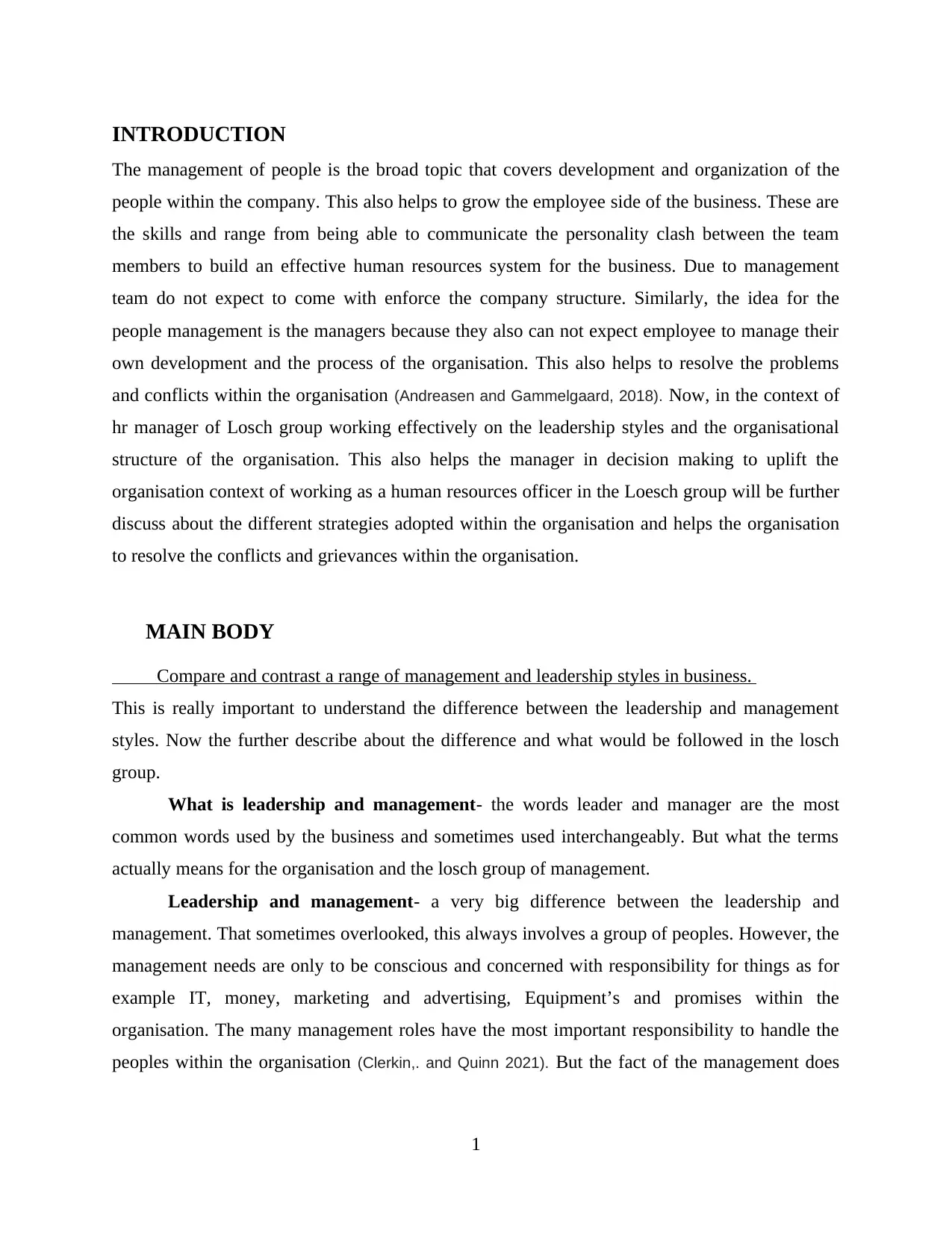
INTRODUCTION
The management of people is the broad topic that covers development and organization of the
people within the company. This also helps to grow the employee side of the business. These are
the skills and range from being able to communicate the personality clash between the team
members to build an effective human resources system for the business. Due to management
team do not expect to come with enforce the company structure. Similarly, the idea for the
people management is the managers because they also can not expect employee to manage their
own development and the process of the organisation. This also helps to resolve the problems
and conflicts within the organisation (Andreasen and Gammelgaard, 2018). Now, in the context of
hr manager of Losch group working effectively on the leadership styles and the organisational
structure of the organisation. This also helps the manager in decision making to uplift the
organisation context of working as a human resources officer in the Loesch group will be further
discuss about the different strategies adopted within the organisation and helps the organisation
to resolve the conflicts and grievances within the organisation.
MAIN BODY
Compare and contrast a range of management and leadership styles in business.
This is really important to understand the difference between the leadership and management
styles. Now the further describe about the difference and what would be followed in the losch
group.
What is leadership and management- the words leader and manager are the most
common words used by the business and sometimes used interchangeably. But what the terms
actually means for the organisation and the losch group of management.
Leadership and management- a very big difference between the leadership and
management. That sometimes overlooked, this always involves a group of peoples. However, the
management needs are only to be conscious and concerned with responsibility for things as for
example IT, money, marketing and advertising, Equipment’s and promises within the
organisation. The many management roles have the most important responsibility to handle the
peoples within the organisation (Clerkin,. and Quinn 2021). But the fact of the management does
1
The management of people is the broad topic that covers development and organization of the
people within the company. This also helps to grow the employee side of the business. These are
the skills and range from being able to communicate the personality clash between the team
members to build an effective human resources system for the business. Due to management
team do not expect to come with enforce the company structure. Similarly, the idea for the
people management is the managers because they also can not expect employee to manage their
own development and the process of the organisation. This also helps to resolve the problems
and conflicts within the organisation (Andreasen and Gammelgaard, 2018). Now, in the context of
hr manager of Losch group working effectively on the leadership styles and the organisational
structure of the organisation. This also helps the manager in decision making to uplift the
organisation context of working as a human resources officer in the Loesch group will be further
discuss about the different strategies adopted within the organisation and helps the organisation
to resolve the conflicts and grievances within the organisation.
MAIN BODY
Compare and contrast a range of management and leadership styles in business.
This is really important to understand the difference between the leadership and management
styles. Now the further describe about the difference and what would be followed in the losch
group.
What is leadership and management- the words leader and manager are the most
common words used by the business and sometimes used interchangeably. But what the terms
actually means for the organisation and the losch group of management.
Leadership and management- a very big difference between the leadership and
management. That sometimes overlooked, this always involves a group of peoples. However, the
management needs are only to be conscious and concerned with responsibility for things as for
example IT, money, marketing and advertising, Equipment’s and promises within the
organisation. The many management roles have the most important responsibility to handle the
peoples within the organisation (Clerkin,. and Quinn 2021). But the fact of the management does
1
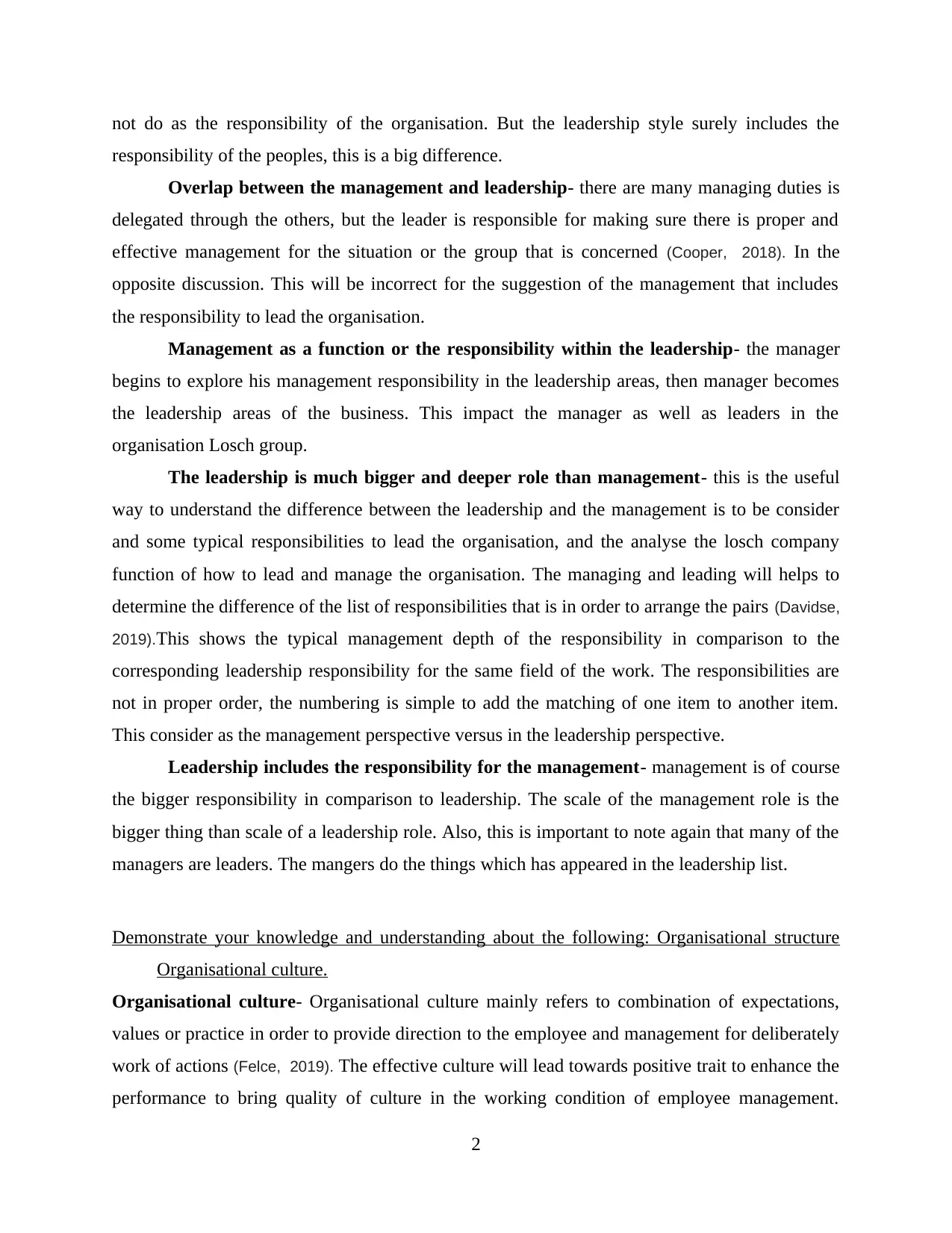
not do as the responsibility of the organisation. But the leadership style surely includes the
responsibility of the peoples, this is a big difference.
Overlap between the management and leadership- there are many managing duties is
delegated through the others, but the leader is responsible for making sure there is proper and
effective management for the situation or the group that is concerned (Cooper, 2018). In the
opposite discussion. This will be incorrect for the suggestion of the management that includes
the responsibility to lead the organisation.
Management as a function or the responsibility within the leadership- the manager
begins to explore his management responsibility in the leadership areas, then manager becomes
the leadership areas of the business. This impact the manager as well as leaders in the
organisation Losch group.
The leadership is much bigger and deeper role than management- this is the useful
way to understand the difference between the leadership and the management is to be consider
and some typical responsibilities to lead the organisation, and the analyse the losch company
function of how to lead and manage the organisation. The managing and leading will helps to
determine the difference of the list of responsibilities that is in order to arrange the pairs (Davidse,
2019).This shows the typical management depth of the responsibility in comparison to the
corresponding leadership responsibility for the same field of the work. The responsibilities are
not in proper order, the numbering is simple to add the matching of one item to another item.
This consider as the management perspective versus in the leadership perspective.
Leadership includes the responsibility for the management- management is of course
the bigger responsibility in comparison to leadership. The scale of the management role is the
bigger thing than scale of a leadership role. Also, this is important to note again that many of the
managers are leaders. The mangers do the things which has appeared in the leadership list.
Demonstrate your knowledge and understanding about the following: Organisational structure
Organisational culture.
Organisational culture- Organisational culture mainly refers to combination of expectations,
values or practice in order to provide direction to the employee and management for deliberately
work of actions (Felce, 2019). The effective culture will lead towards positive trait to enhance the
performance to bring quality of culture in the working condition of employee management.
2
responsibility of the peoples, this is a big difference.
Overlap between the management and leadership- there are many managing duties is
delegated through the others, but the leader is responsible for making sure there is proper and
effective management for the situation or the group that is concerned (Cooper, 2018). In the
opposite discussion. This will be incorrect for the suggestion of the management that includes
the responsibility to lead the organisation.
Management as a function or the responsibility within the leadership- the manager
begins to explore his management responsibility in the leadership areas, then manager becomes
the leadership areas of the business. This impact the manager as well as leaders in the
organisation Losch group.
The leadership is much bigger and deeper role than management- this is the useful
way to understand the difference between the leadership and the management is to be consider
and some typical responsibilities to lead the organisation, and the analyse the losch company
function of how to lead and manage the organisation. The managing and leading will helps to
determine the difference of the list of responsibilities that is in order to arrange the pairs (Davidse,
2019).This shows the typical management depth of the responsibility in comparison to the
corresponding leadership responsibility for the same field of the work. The responsibilities are
not in proper order, the numbering is simple to add the matching of one item to another item.
This consider as the management perspective versus in the leadership perspective.
Leadership includes the responsibility for the management- management is of course
the bigger responsibility in comparison to leadership. The scale of the management role is the
bigger thing than scale of a leadership role. Also, this is important to note again that many of the
managers are leaders. The mangers do the things which has appeared in the leadership list.
Demonstrate your knowledge and understanding about the following: Organisational structure
Organisational culture.
Organisational culture- Organisational culture mainly refers to combination of expectations,
values or practice in order to provide direction to the employee and management for deliberately
work of actions (Felce, 2019). The effective culture will lead towards positive trait to enhance the
performance to bring quality of culture in the working condition of employee management.
2
⊘ This is a preview!⊘
Do you want full access?
Subscribe today to unlock all pages.

Trusted by 1+ million students worldwide
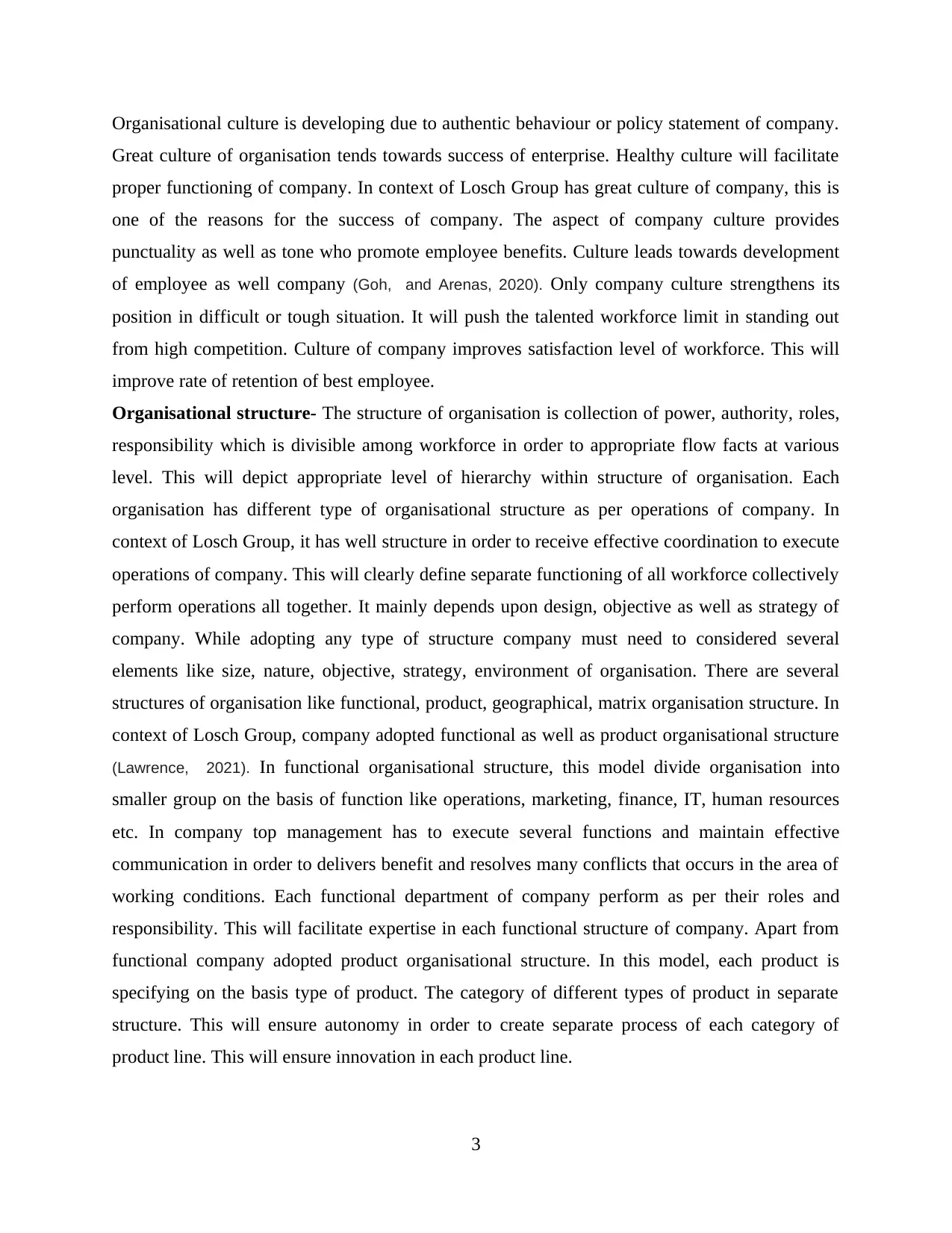
Organisational culture is developing due to authentic behaviour or policy statement of company.
Great culture of organisation tends towards success of enterprise. Healthy culture will facilitate
proper functioning of company. In context of Losch Group has great culture of company, this is
one of the reasons for the success of company. The aspect of company culture provides
punctuality as well as tone who promote employee benefits. Culture leads towards development
of employee as well company (Goh, and Arenas, 2020). Only company culture strengthens its
position in difficult or tough situation. It will push the talented workforce limit in standing out
from high competition. Culture of company improves satisfaction level of workforce. This will
improve rate of retention of best employee.
Organisational structure- The structure of organisation is collection of power, authority, roles,
responsibility which is divisible among workforce in order to appropriate flow facts at various
level. This will depict appropriate level of hierarchy within structure of organisation. Each
organisation has different type of organisational structure as per operations of company. In
context of Losch Group, it has well structure in order to receive effective coordination to execute
operations of company. This will clearly define separate functioning of all workforce collectively
perform operations all together. It mainly depends upon design, objective as well as strategy of
company. While adopting any type of structure company must need to considered several
elements like size, nature, objective, strategy, environment of organisation. There are several
structures of organisation like functional, product, geographical, matrix organisation structure. In
context of Losch Group, company adopted functional as well as product organisational structure
(Lawrence, 2021). In functional organisational structure, this model divide organisation into
smaller group on the basis of function like operations, marketing, finance, IT, human resources
etc. In company top management has to execute several functions and maintain effective
communication in order to delivers benefit and resolves many conflicts that occurs in the area of
working conditions. Each functional department of company perform as per their roles and
responsibility. This will facilitate expertise in each functional structure of company. Apart from
functional company adopted product organisational structure. In this model, each product is
specifying on the basis type of product. The category of different types of product in separate
structure. This will ensure autonomy in order to create separate process of each category of
product line. This will ensure innovation in each product line.
3
Great culture of organisation tends towards success of enterprise. Healthy culture will facilitate
proper functioning of company. In context of Losch Group has great culture of company, this is
one of the reasons for the success of company. The aspect of company culture provides
punctuality as well as tone who promote employee benefits. Culture leads towards development
of employee as well company (Goh, and Arenas, 2020). Only company culture strengthens its
position in difficult or tough situation. It will push the talented workforce limit in standing out
from high competition. Culture of company improves satisfaction level of workforce. This will
improve rate of retention of best employee.
Organisational structure- The structure of organisation is collection of power, authority, roles,
responsibility which is divisible among workforce in order to appropriate flow facts at various
level. This will depict appropriate level of hierarchy within structure of organisation. Each
organisation has different type of organisational structure as per operations of company. In
context of Losch Group, it has well structure in order to receive effective coordination to execute
operations of company. This will clearly define separate functioning of all workforce collectively
perform operations all together. It mainly depends upon design, objective as well as strategy of
company. While adopting any type of structure company must need to considered several
elements like size, nature, objective, strategy, environment of organisation. There are several
structures of organisation like functional, product, geographical, matrix organisation structure. In
context of Losch Group, company adopted functional as well as product organisational structure
(Lawrence, 2021). In functional organisational structure, this model divide organisation into
smaller group on the basis of function like operations, marketing, finance, IT, human resources
etc. In company top management has to execute several functions and maintain effective
communication in order to delivers benefit and resolves many conflicts that occurs in the area of
working conditions. Each functional department of company perform as per their roles and
responsibility. This will facilitate expertise in each functional structure of company. Apart from
functional company adopted product organisational structure. In this model, each product is
specifying on the basis type of product. The category of different types of product in separate
structure. This will ensure autonomy in order to create separate process of each category of
product line. This will ensure innovation in each product line.
3
Paraphrase This Document
Need a fresh take? Get an instant paraphrase of this document with our AI Paraphraser

Relationship among organisational culture and structure- The organisational structure and
culture are attached with the performance of organisation. Culture somewhere describe
structure of company on the other hand structure also describe culture within organisation.
The structure may be referring as framework in order to implement culture of company.
Apart from this, organisational culture depicts and provides overall format of structure.
research on legal requirement about equal opportunity and benefit of diversity
The term equality and diversity are about promoting and fostering everyone within the
organisation like losch group. Everyone right is being different about to free from the
discrimination and giving value to the individual and having the choice of dignity with giving
right to the own beliefs and values in the organisation. Diversity is a word that means to the
losch group and this is different from the other countries. The diversity in the organisation is
more important than the equity (Østergaard, 2020). The equity is all about creating the culture that
values have the particular difference and variety of the advantages and society of the particular
individuals within the organisation. The diversity in the workforce is important because the
organisation can offer the different variety idea and skills to the employee and energies their
business to give the competitive advantage. This is the much wider equipment to bring the talents
of the organisation which happens by the help of organisation. This will provide the benefits in
the broader way. This improves the productivity and enhances the range of the profile of the
employee within the organisation. Some of the main important benefits of the organisation to
provide the knowledge of the different areas of the community that can be utilised within the
organisation. This also gives the better understanding of the product as well as market segment
and behaviour of the consumers and how the consumers can attain within the organisation. This
also can become an employer choice. Every work can be taking place in the vibrant and inclusive
to nurture the environment. The equal opportunities are treated as the individuals without
judgements that being made of them that is based on the stereotype. This understanding is
appreciating and valuing that all staff members have different sets and skills and the capabilities
and using the difference for the better personal and organisational results. The working
environment is generated and fostered, where the peoples of every background and the
experience feel motivated and valued within the organisation. When the discussion is about the
equal opportunities within the organisation, these policies are designed to protect the certain
4
culture are attached with the performance of organisation. Culture somewhere describe
structure of company on the other hand structure also describe culture within organisation.
The structure may be referring as framework in order to implement culture of company.
Apart from this, organisational culture depicts and provides overall format of structure.
research on legal requirement about equal opportunity and benefit of diversity
The term equality and diversity are about promoting and fostering everyone within the
organisation like losch group. Everyone right is being different about to free from the
discrimination and giving value to the individual and having the choice of dignity with giving
right to the own beliefs and values in the organisation. Diversity is a word that means to the
losch group and this is different from the other countries. The diversity in the organisation is
more important than the equity (Østergaard, 2020). The equity is all about creating the culture that
values have the particular difference and variety of the advantages and society of the particular
individuals within the organisation. The diversity in the workforce is important because the
organisation can offer the different variety idea and skills to the employee and energies their
business to give the competitive advantage. This is the much wider equipment to bring the talents
of the organisation which happens by the help of organisation. This will provide the benefits in
the broader way. This improves the productivity and enhances the range of the profile of the
employee within the organisation. Some of the main important benefits of the organisation to
provide the knowledge of the different areas of the community that can be utilised within the
organisation. This also gives the better understanding of the product as well as market segment
and behaviour of the consumers and how the consumers can attain within the organisation. This
also can become an employer choice. Every work can be taking place in the vibrant and inclusive
to nurture the environment. The equal opportunities are treated as the individuals without
judgements that being made of them that is based on the stereotype. This understanding is
appreciating and valuing that all staff members have different sets and skills and the capabilities
and using the difference for the better personal and organisational results. The working
environment is generated and fostered, where the peoples of every background and the
experience feel motivated and valued within the organisation. When the discussion is about the
equal opportunities within the organisation, these policies are designed to protect the certain
4
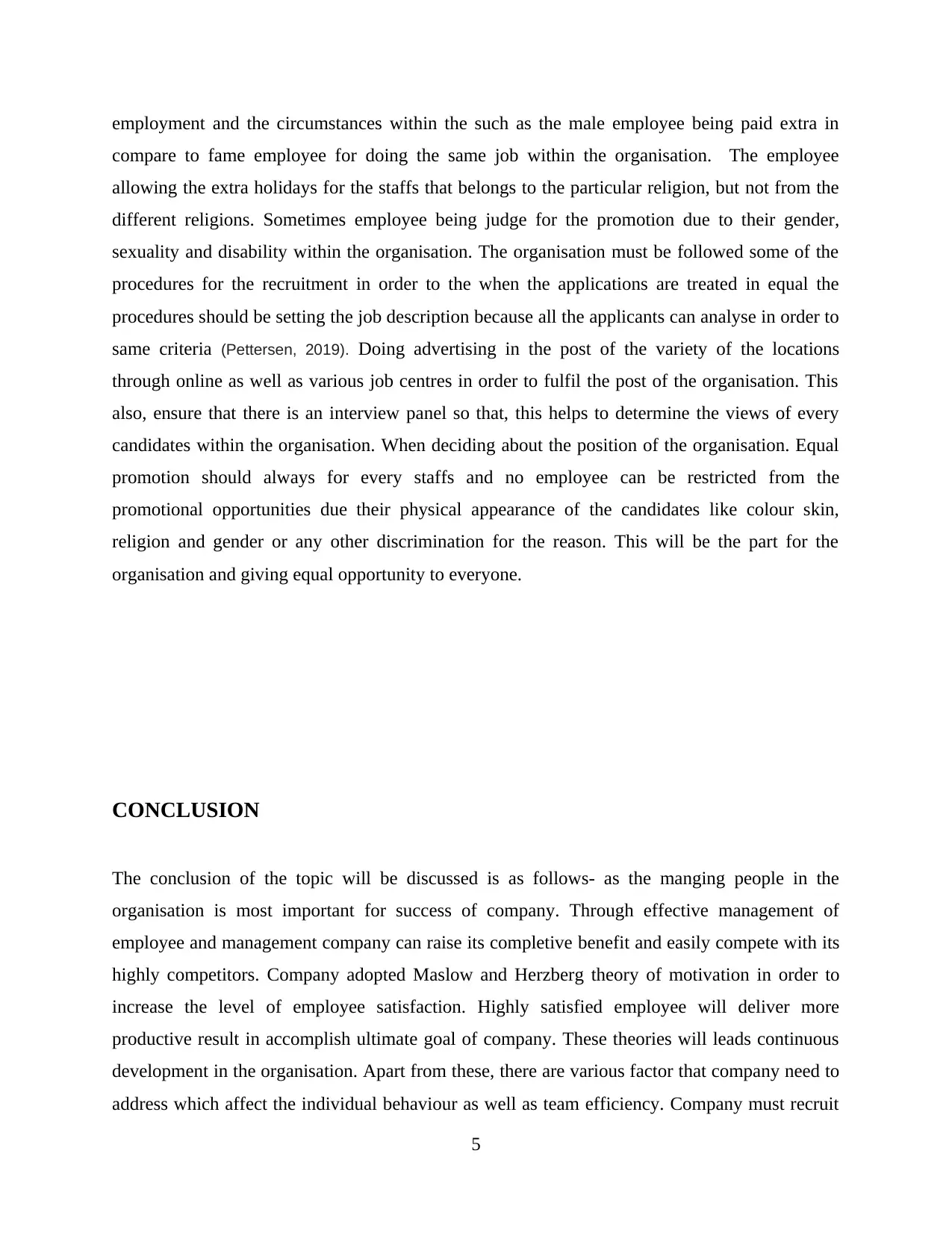
employment and the circumstances within the such as the male employee being paid extra in
compare to fame employee for doing the same job within the organisation. The employee
allowing the extra holidays for the staffs that belongs to the particular religion, but not from the
different religions. Sometimes employee being judge for the promotion due to their gender,
sexuality and disability within the organisation. The organisation must be followed some of the
procedures for the recruitment in order to the when the applications are treated in equal the
procedures should be setting the job description because all the applicants can analyse in order to
same criteria (Pettersen, 2019). Doing advertising in the post of the variety of the locations
through online as well as various job centres in order to fulfil the post of the organisation. This
also, ensure that there is an interview panel so that, this helps to determine the views of every
candidates within the organisation. When deciding about the position of the organisation. Equal
promotion should always for every staffs and no employee can be restricted from the
promotional opportunities due their physical appearance of the candidates like colour skin,
religion and gender or any other discrimination for the reason. This will be the part for the
organisation and giving equal opportunity to everyone.
CONCLUSION
The conclusion of the topic will be discussed is as follows- as the manging people in the
organisation is most important for success of company. Through effective management of
employee and management company can raise its completive benefit and easily compete with its
highly competitors. Company adopted Maslow and Herzberg theory of motivation in order to
increase the level of employee satisfaction. Highly satisfied employee will deliver more
productive result in accomplish ultimate goal of company. These theories will leads continuous
development in the organisation. Apart from these, there are various factor that company need to
address which affect the individual behaviour as well as team efficiency. Company must recruit
5
compare to fame employee for doing the same job within the organisation. The employee
allowing the extra holidays for the staffs that belongs to the particular religion, but not from the
different religions. Sometimes employee being judge for the promotion due to their gender,
sexuality and disability within the organisation. The organisation must be followed some of the
procedures for the recruitment in order to the when the applications are treated in equal the
procedures should be setting the job description because all the applicants can analyse in order to
same criteria (Pettersen, 2019). Doing advertising in the post of the variety of the locations
through online as well as various job centres in order to fulfil the post of the organisation. This
also, ensure that there is an interview panel so that, this helps to determine the views of every
candidates within the organisation. When deciding about the position of the organisation. Equal
promotion should always for every staffs and no employee can be restricted from the
promotional opportunities due their physical appearance of the candidates like colour skin,
religion and gender or any other discrimination for the reason. This will be the part for the
organisation and giving equal opportunity to everyone.
CONCLUSION
The conclusion of the topic will be discussed is as follows- as the manging people in the
organisation is most important for success of company. Through effective management of
employee and management company can raise its completive benefit and easily compete with its
highly competitors. Company adopted Maslow and Herzberg theory of motivation in order to
increase the level of employee satisfaction. Highly satisfied employee will deliver more
productive result in accomplish ultimate goal of company. These theories will leads continuous
development in the organisation. Apart from these, there are various factor that company need to
address which affect the individual behaviour as well as team efficiency. Company must recruit
5
⊘ This is a preview!⊘
Do you want full access?
Subscribe today to unlock all pages.

Trusted by 1+ million students worldwide
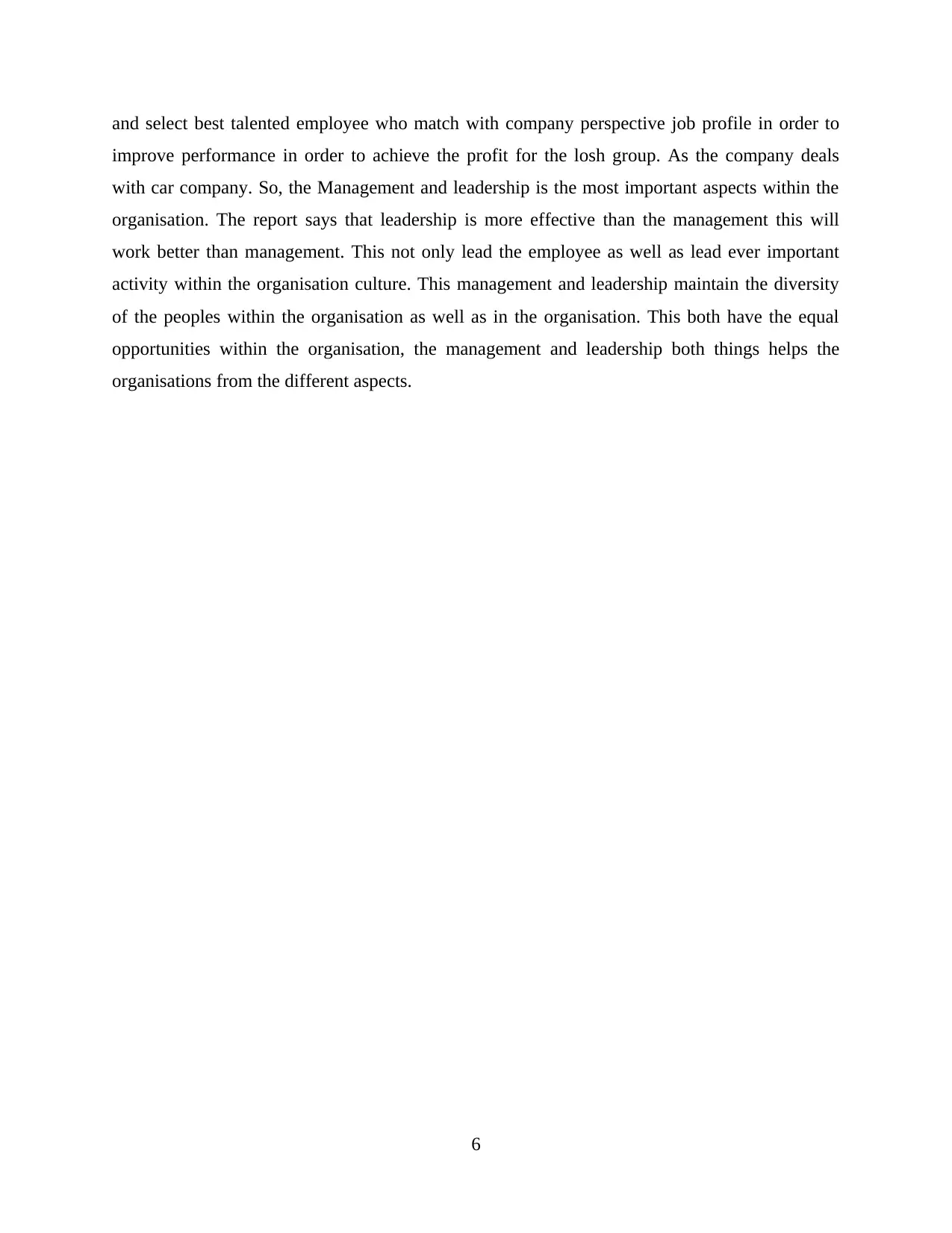
and select best talented employee who match with company perspective job profile in order to
improve performance in order to achieve the profit for the losh group. As the company deals
with car company. So, the Management and leadership is the most important aspects within the
organisation. The report says that leadership is more effective than the management this will
work better than management. This not only lead the employee as well as lead ever important
activity within the organisation culture. This management and leadership maintain the diversity
of the peoples within the organisation as well as in the organisation. This both have the equal
opportunities within the organisation, the management and leadership both things helps the
organisations from the different aspects.
6
improve performance in order to achieve the profit for the losh group. As the company deals
with car company. So, the Management and leadership is the most important aspects within the
organisation. The report says that leadership is more effective than the management this will
work better than management. This not only lead the employee as well as lead ever important
activity within the organisation culture. This management and leadership maintain the diversity
of the peoples within the organisation as well as in the organisation. This both have the equal
opportunities within the organisation, the management and leadership both things helps the
organisations from the different aspects.
6
Paraphrase This Document
Need a fresh take? Get an instant paraphrase of this document with our AI Paraphraser
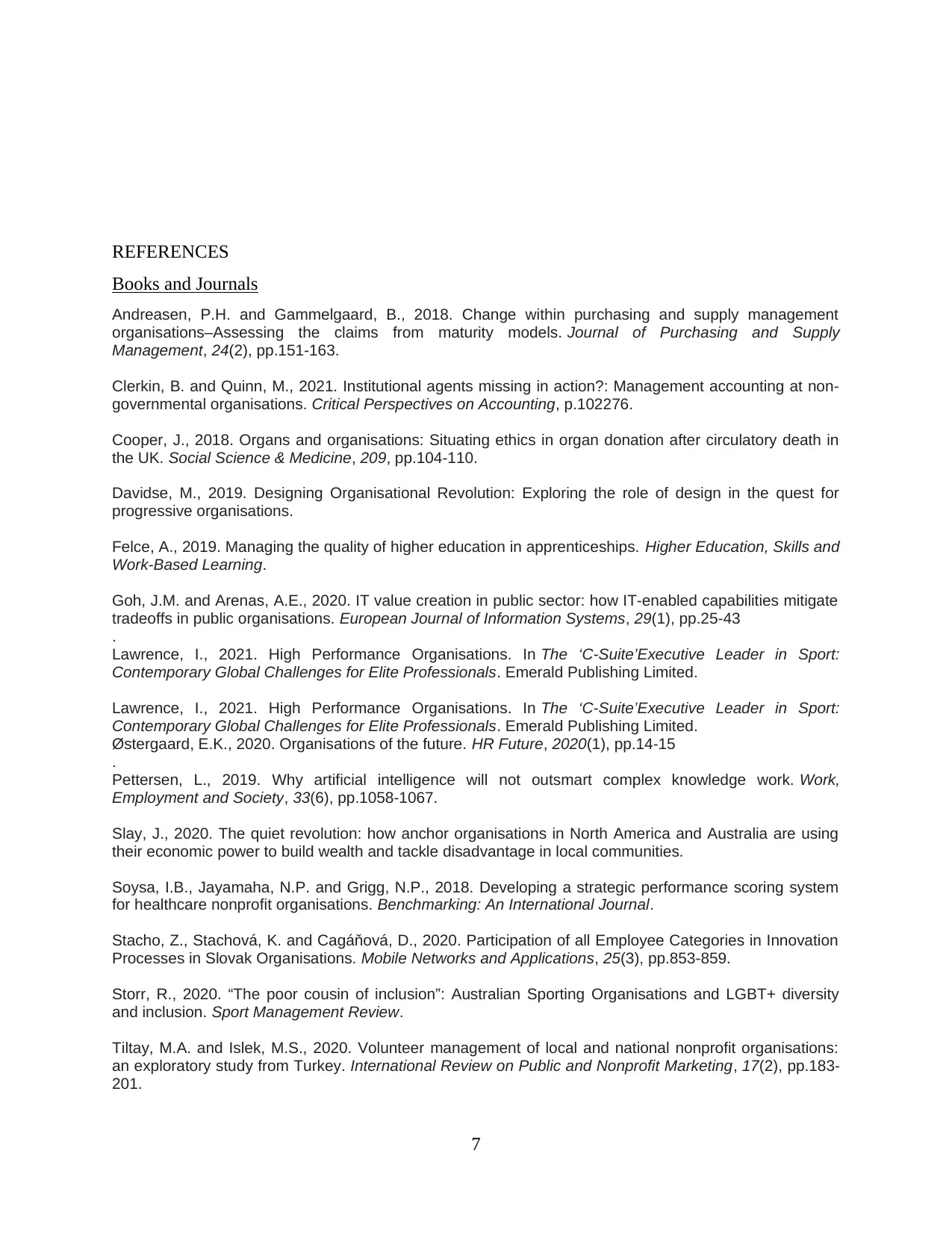
REFERENCES
Books and Journals
Andreasen, P.H. and Gammelgaard, B., 2018. Change within purchasing and supply management
organisations–Assessing the claims from maturity models. Journal of Purchasing and Supply
Management, 24(2), pp.151-163.
Clerkin, B. and Quinn, M., 2021. Institutional agents missing in action?: Management accounting at non-
governmental organisations. Critical Perspectives on Accounting, p.102276.
Cooper, J., 2018. Organs and organisations: Situating ethics in organ donation after circulatory death in
the UK. Social Science & Medicine, 209, pp.104-110.
Davidse, M., 2019. Designing Organisational Revolution: Exploring the role of design in the quest for
progressive organisations.
Felce, A., 2019. Managing the quality of higher education in apprenticeships. Higher Education, Skills and
Work-Based Learning.
Goh, J.M. and Arenas, A.E., 2020. IT value creation in public sector: how IT-enabled capabilities mitigate
tradeoffs in public organisations. European Journal of Information Systems, 29(1), pp.25-43
.
Lawrence, I., 2021. High Performance Organisations. In The ‘C-Suite’Executive Leader in Sport:
Contemporary Global Challenges for Elite Professionals. Emerald Publishing Limited.
Lawrence, I., 2021. High Performance Organisations. In The ‘C-Suite’Executive Leader in Sport:
Contemporary Global Challenges for Elite Professionals. Emerald Publishing Limited.
Østergaard, E.K., 2020. Organisations of the future. HR Future, 2020(1), pp.14-15
.
Pettersen, L., 2019. Why artificial intelligence will not outsmart complex knowledge work. Work,
Employment and Society, 33(6), pp.1058-1067.
Slay, J., 2020. The quiet revolution: how anchor organisations in North America and Australia are using
their economic power to build wealth and tackle disadvantage in local communities.
Soysa, I.B., Jayamaha, N.P. and Grigg, N.P., 2018. Developing a strategic performance scoring system
for healthcare nonprofit organisations. Benchmarking: An International Journal.
Stacho, Z., Stachová, K. and Cagáňová, D., 2020. Participation of all Employee Categories in Innovation
Processes in Slovak Organisations. Mobile Networks and Applications, 25(3), pp.853-859.
Storr, R., 2020. “The poor cousin of inclusion”: Australian Sporting Organisations and LGBT+ diversity
and inclusion. Sport Management Review.
Tiltay, M.A. and Islek, M.S., 2020. Volunteer management of local and national nonprofit organisations:
an exploratory study from Turkey. International Review on Public and Nonprofit Marketing, 17(2), pp.183-
201.
7
Books and Journals
Andreasen, P.H. and Gammelgaard, B., 2018. Change within purchasing and supply management
organisations–Assessing the claims from maturity models. Journal of Purchasing and Supply
Management, 24(2), pp.151-163.
Clerkin, B. and Quinn, M., 2021. Institutional agents missing in action?: Management accounting at non-
governmental organisations. Critical Perspectives on Accounting, p.102276.
Cooper, J., 2018. Organs and organisations: Situating ethics in organ donation after circulatory death in
the UK. Social Science & Medicine, 209, pp.104-110.
Davidse, M., 2019. Designing Organisational Revolution: Exploring the role of design in the quest for
progressive organisations.
Felce, A., 2019. Managing the quality of higher education in apprenticeships. Higher Education, Skills and
Work-Based Learning.
Goh, J.M. and Arenas, A.E., 2020. IT value creation in public sector: how IT-enabled capabilities mitigate
tradeoffs in public organisations. European Journal of Information Systems, 29(1), pp.25-43
.
Lawrence, I., 2021. High Performance Organisations. In The ‘C-Suite’Executive Leader in Sport:
Contemporary Global Challenges for Elite Professionals. Emerald Publishing Limited.
Lawrence, I., 2021. High Performance Organisations. In The ‘C-Suite’Executive Leader in Sport:
Contemporary Global Challenges for Elite Professionals. Emerald Publishing Limited.
Østergaard, E.K., 2020. Organisations of the future. HR Future, 2020(1), pp.14-15
.
Pettersen, L., 2019. Why artificial intelligence will not outsmart complex knowledge work. Work,
Employment and Society, 33(6), pp.1058-1067.
Slay, J., 2020. The quiet revolution: how anchor organisations in North America and Australia are using
their economic power to build wealth and tackle disadvantage in local communities.
Soysa, I.B., Jayamaha, N.P. and Grigg, N.P., 2018. Developing a strategic performance scoring system
for healthcare nonprofit organisations. Benchmarking: An International Journal.
Stacho, Z., Stachová, K. and Cagáňová, D., 2020. Participation of all Employee Categories in Innovation
Processes in Slovak Organisations. Mobile Networks and Applications, 25(3), pp.853-859.
Storr, R., 2020. “The poor cousin of inclusion”: Australian Sporting Organisations and LGBT+ diversity
and inclusion. Sport Management Review.
Tiltay, M.A. and Islek, M.S., 2020. Volunteer management of local and national nonprofit organisations:
an exploratory study from Turkey. International Review on Public and Nonprofit Marketing, 17(2), pp.183-
201.
7
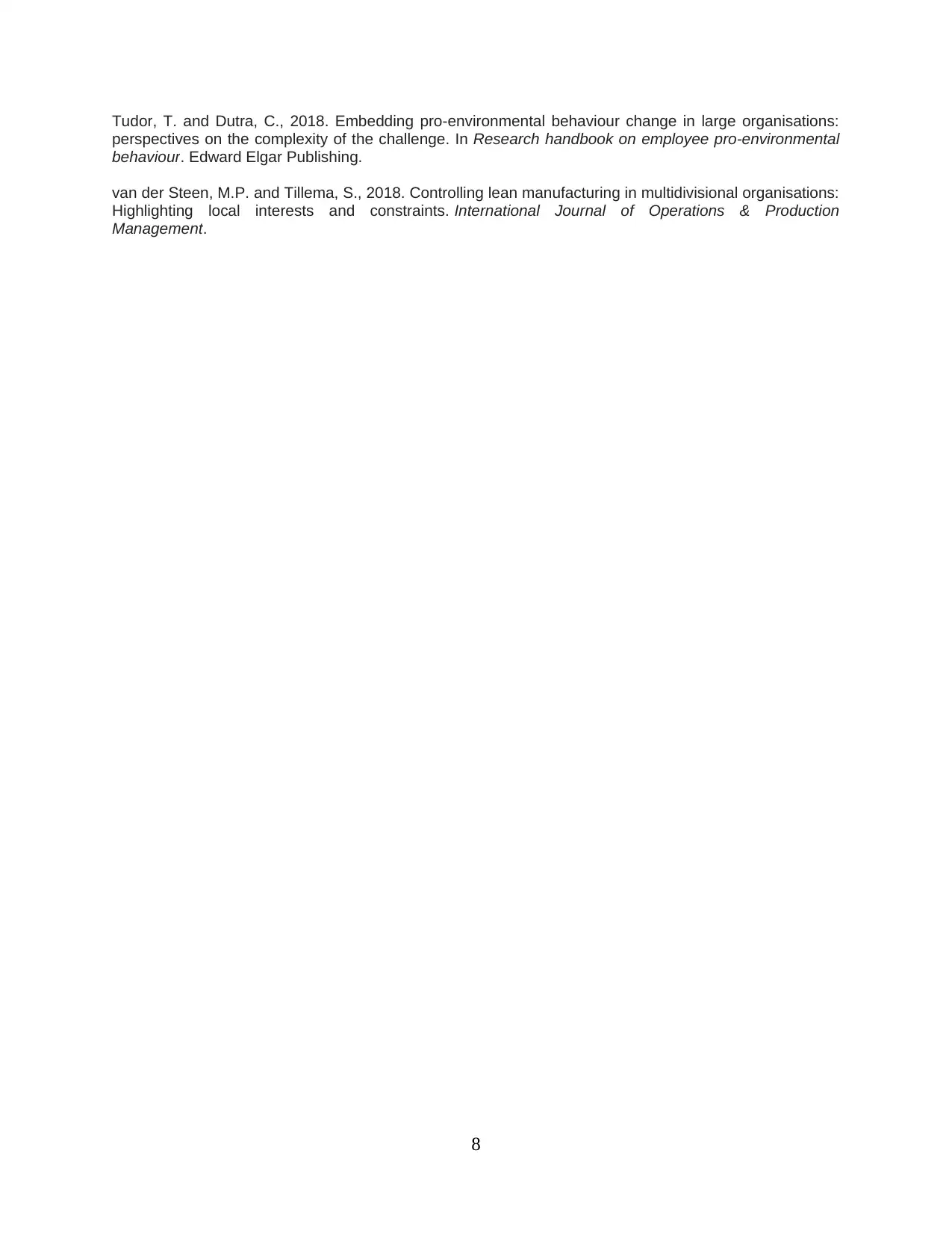
Tudor, T. and Dutra, C., 2018. Embedding pro-environmental behaviour change in large organisations:
perspectives on the complexity of the challenge. In Research handbook on employee pro-environmental
behaviour. Edward Elgar Publishing.
van der Steen, M.P. and Tillema, S., 2018. Controlling lean manufacturing in multidivisional organisations:
Highlighting local interests and constraints. International Journal of Operations & Production
Management.
8
perspectives on the complexity of the challenge. In Research handbook on employee pro-environmental
behaviour. Edward Elgar Publishing.
van der Steen, M.P. and Tillema, S., 2018. Controlling lean manufacturing in multidivisional organisations:
Highlighting local interests and constraints. International Journal of Operations & Production
Management.
8
⊘ This is a preview!⊘
Do you want full access?
Subscribe today to unlock all pages.

Trusted by 1+ million students worldwide
1 out of 9
Related Documents
Your All-in-One AI-Powered Toolkit for Academic Success.
+13062052269
info@desklib.com
Available 24*7 on WhatsApp / Email
![[object Object]](/_next/static/media/star-bottom.7253800d.svg)
Unlock your academic potential
Copyright © 2020–2025 A2Z Services. All Rights Reserved. Developed and managed by ZUCOL.





